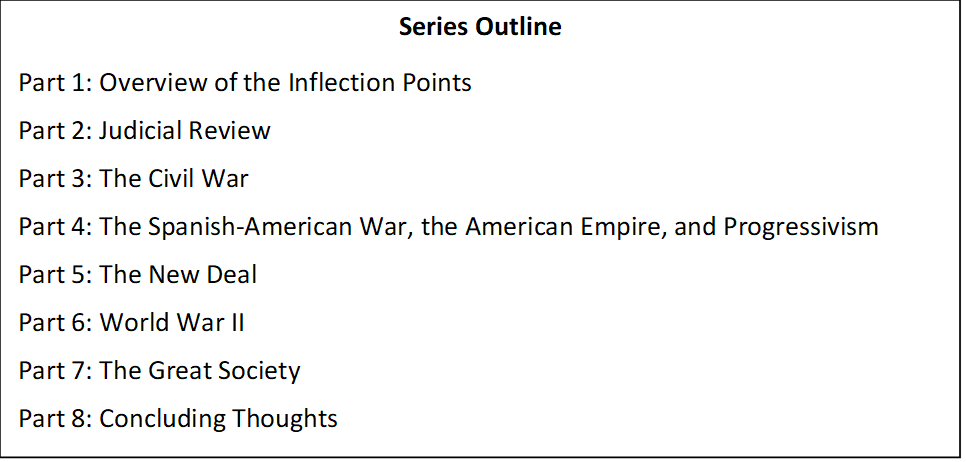
Power Shift, Part 6: World War II
A command economy is a key aspect of a political system in which a central governmental authority dictates the levels of production that are permissible and the prices that may be charged for goods and services. Most industries are publicly owned.
Abstract: World War II poses an interesting problem. Can decentralized states fight and win a global war and be be a superpower?
By the definition above, the US was a command economy in World War II. Factories shifted from consumer goods to war materials and equipment, coordinate by the federal government. President Franklin Roosevelt created the War Production Board by executive order in January 1942 to coordinate industrial efforts. The strong US system turned out thousands of tanks, planes, and ships. The government coordinated production and dictated wages. The system was highly productive, and the US combined its ingenuity with its productive base to produce some breathtaking technological leaps as well as sheer quantity. Then, when the war was over, the US shifted from the wartime command economy back to a market economy. This economic pirouette was as breathtaking as Patton’s Third Army executing an enormous shift to the north to counter the German attack in the Battle of the Bulge.
During the command economy, individual companies were not free to set their own wages. Therefore, they used fringe benefits to attract workers. Our system of employer provided healthcare is an artifact of the World War II command economy. But there are other powerful artifacts from WWII as well.
The US transitioned from a world power focused on its own region to a globally engaged superpower. In this role, the US rebuilt Europe and Japan and became the world’s police. The government did not have to take this route. Just as it demobilized the economy and much of the military, it could have returned to a regional hegemon and focus on internal development and the region. Yet it did not. Perhaps, remembering US disengagement after World War I and the disastrous Treaty of Versailles, leaders felt they needed to stay engaged in Europe and Japan to counter the Soviet Union. The tagline was to keep the world safe for democracy.
To do this, leaders felt they needed to build nuclear capabilities and engage the non-communist world. George Kennan developed the concept of containment in 1947 to enable this effort. This policy drove US diplomatic and military strategy for decades. It also drove the need for US military reform and spending. Government spending fell from the war years but stayed significantly higher than prior history. The US also created the Atomic Energy Commission (AEC) to manage the nuclear arsenal and nuclear research and development. After the 1973 oil crisis, the AEC and its successor, the Nuclear Regulatory Commission, became the core of a new Department of Energy.
The question is whether the US could become a superpower without an extremely strong central government that could set and enforce policies over the states and various institutions. A large part of this control needed to be fiscal. A superpower requires a great deal of wealth to fund military efforts and diplomatic initiatives. A state’s primary vehicle for income is through taxation. The 16th Amendment provided the vehicle for both taxation and discretionary spending.
The growth of a professional federal bureaucracy provided the regulatory and administrative muscle to build and sustain the requirements of a superpower. The flow from the American Empire to American superpower in retrospect seems smooth and intentional. The constitutional amendments and change in the federal bureaucracy seemed to flow through the New Deal and into the age of the superpower. While I am not at all sure this was a guided path, there are conspiracy theories, such as the Trilateral Commission theory, that say it was. Whatever the reason; plan or serendipity, the changes before WWII facilitated American mobilization and success during the war and the emergence of an American superpower.
By the 1950s, the stage was set for both superpower rivalry with the Soviet Union and significant changes within American society. The 1950s saw the beginning of the Civil Rights Era that laid the groundwork for the Great Society that followed it. The US government now had the power, the tools, and the funding to compel states to comply with federal mandates for racial integration and civil rights. The 1950s saw the cases of Sweatt v. Painter (1950), Brown v. Board of Education (1954) and, Hernandez v. Texas (1954). During this time, the federal government intervened in state education policy to integrate schools and even sent federal troops to enforce it.
The federal government was now clearly in charge and willing to use legal and military force to compel the states to abide by its will.
Addendum
I made comment that the command economy was rolled back after WWII. While for the most part that is true, there were two laws that could be used to reinstate parts of the command economy:
Another source of authority came from the Defense Production Act of 1950, which allowed the president to seize property whenever he believed “that the use of any equipment, supplies, or component parts thereof, or materials or facilities necessary for the manufacture, servicing, or operation of such equipment, supplies, or component parts, is needed for the national defense.” This statute represented an explicit extension of the federal government’s eminent domain powers, which were limited in this case, as in others, by the requirement that the property owner be paid just compensation.7 Still another possibility was Section 18 of the Selective Service Act of 1948. That section stipulated that the president could order from any manufacturer that produced goods needed by the military or the Atomic Energy Commission, once the contents of the order had been approved by Congress. If a manufacturer failed to fulfill the order by the president’s deadline, the president could have that manufacturer’s property seized and operated for the purpose of producing the goods needed by the government. As in the Defense Production Act, just compensation to the owner was required.
Thomas E. Woods; Gutzman, Kevin R. C.. Who Killed the Constitution? (pp. 25-26). The Crown Publishing Group. Kindle Edition.






